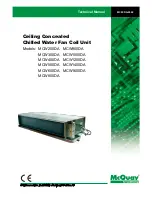
74
AGZ 025D through 190D
OMM 1166-1
Liquid Line Sight Glass
The refrigerant sight glasses should be
observed periodically (a weekly observation
should be adequate.) A clear glass of liquid
indicates that there is subcooled refrigerant
charge in the system. Bubbling refrigerant in
the sight glass, during stable run conditions,
indicates that the system can be short of
refrigerant charge. Refrigerant gas flashing in
the sight glass could also indicate an excessive
pressure drop in the liquid line, possibly due to
a clogged filter-drier or a restriction elsewhere
in the liquid line.
See Table 22 on page 77 for maximum
allowable pressure drops. If subcooling is low,
add charge to clear the sight glass. If
subcooling is normal (15 to 20 degrees F) and
flashing is visible in the sight glass, check the
pressure drop across the filter-drier.
Subcooling should be checked at full load with
70
F (21.1
C) ambient temperature, stable
conditions, and all fans running.
An element inside the sight glass indicates the
moisture condition corresponding to a given
element color. If the sight glass does not
indicate a dry condition after about 12 hours of
operation, the circuit should be pumped down
and the filter-drier changed or verify moisture
content by performing an acid test on the
compressor oil.
Planned Maintenance Schedule
OPERATION
WEEKLY
MONTHLY
(Note 1)
ANNUAL
(Note 2)
General
Complete unit log and review (Note 3)
X
Visually inspect unit for loose or damaged components
X
Inspect thermal insulation for integrity
X
Clean and paint as required
X
Electrical
Check terminals for tightness, tighten as necessary
X
Clean control panel interior
X
Visually inspect components for signs of overheating
X
Verify compressor heater operation
X
Test and calibrate equipment protection and operating
controls
X
Megger compressor motor
*
X
Refrigeration
Leak test
X
Check sight glasses for clear flow
X
Check filter-drier pressure drop (see manual for spec)
X
Perform compressor vibration test
X
Acid test oil sample
X
Condenser (air-cooled)
Clean condenser coils (Note 4)
X
Check fan blades for tightness on shaft (Note 5)
X
Check fans for loose rivets and cracks
X
Check coil fins for damage
X
Notes:
1.
Monthly operations include all weekly operations.
2.
Annual (or spring start-up) operations includes all weekly and monthly operations.
3.
Log readings can be taken daily for a higher level of unit observation.
4.
Coil cleaning can be required more frequently in areas with a high level of airborne particles.
5.
Be sure fan motors are electrically locked out.
* Never Megger motors while they are in a vacuum to avoid damage to the motor.
Содержание AGZ 190D
Страница 12: ...12 AGZ 025D through 190D OMM 1166 1 Figure 2 Typical Field Control Wiring...
Страница 81: ......
Страница 82: ......
Страница 83: ......











































